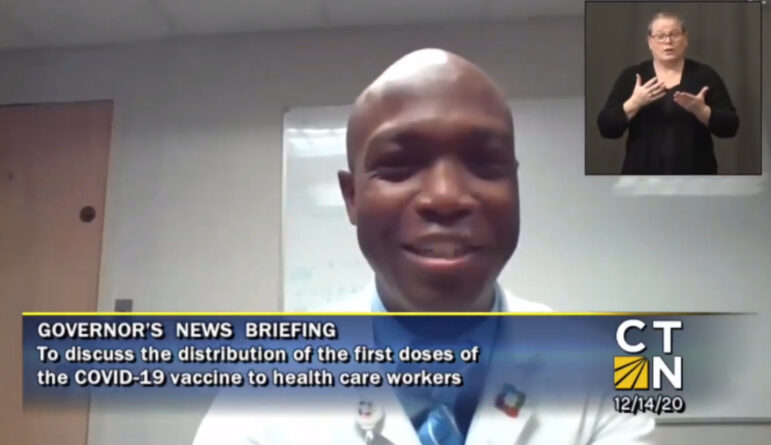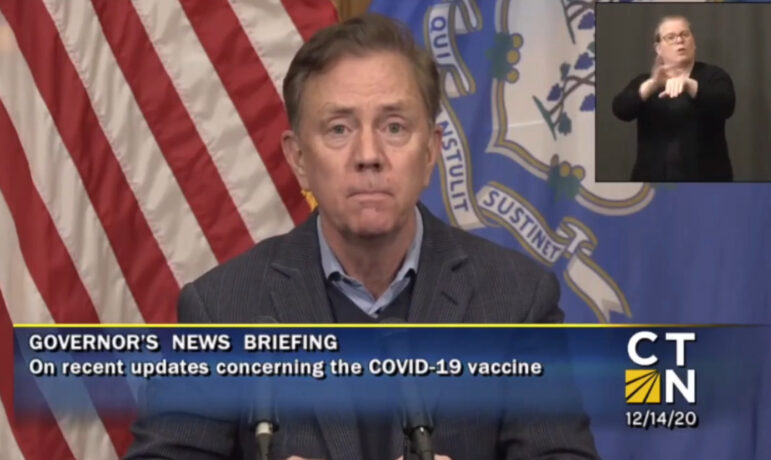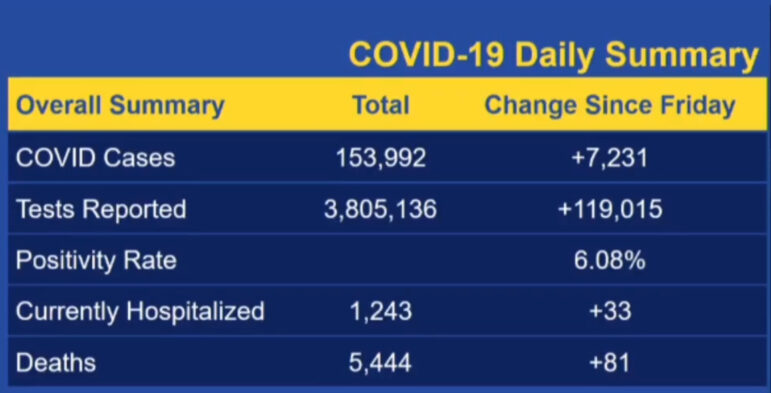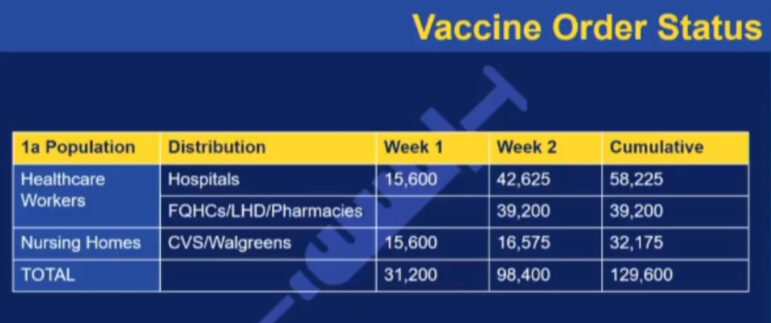Dr. Keith Grant, one of the first people in Connecticut to receive the Pfizer BioNTech Covid-19 vaccine on Monday, joined Governor Lamont’s press conference in the afternoon.
Dr. Grant, a Director of Infection Prevention at Hartford HealthCare, described the experience as a great moment for science, the health care community and Connecticut.
“I feel great,” he said, noting he experienced no short term side effects.

Asking about safeguards in vaccine distribution, he said the CDC had measures in place to ensure that containers of vaccines maintained their required low temperatures.
When reporters brought up the possibility of winter snow storms, he said that while 21 days is advised between first and second doses, there was wiggle room.
“The advice is not to restart the process. If you go over by a few days – a week or so – you should be perfectly fine to still receive the second dose,” he said.


Lamont shared Covid-19 numbers from the previous three days (Friday to Sunday).
There were 81 additional deaths and an additional 33 people hospitalized in Connecticut, although he noted hospitalizations had significant fluctuations.
“I don’t know if we’re bending the curve, but at least we’re trying to flatten it a bit,” he said.
Lamont noted the positivity rate was an early indicator for hospitalizations, but if hospitals get closer to capacity, they can decrease electives.
He also said he believed the arrival of the vaccine would contribute to improved consumer confidence.
“It’s not a silver bullet,” he warned. “I’d like to think, come this spring, when a million people are vaccinated twice – come March – I think people will build confidence, and we’ll get our economy moving again.”

Lamont said he wanted to temper his optimism with caution.
Using a football analogy, he said, “I think I can see the end zone, but there’s an awful lot of blocking and tackling we have to do between here and the final 30 yards…we don’t need another surge like we had after Thanksgiving.”
The Governor said he anticipated the general population would begin to receive the vaccine in late April or May, but that it would depend on the supply chain. He said if Astra-Zeneca’s vaccine is approved, the timeline might move up.
There were several questions from reporters about vaccine confidence and how that might impact vaccine supply and demand.
Dr. Grant said Pfizer’s intent was to create 1.5 billion vaccines within the next 16-18 months, and that, over time, supply and demand would even out.
Lamont said he anticipated demand would outstrip supply in the next three or four months, but, with vaccine production ramping up, and Moderna’s vaccine also becoming available, supply and demand should even out in late spring or summer.
“I think every day you’re going to see somebody like Dr. Grant who took the vaccine. There were no side effects. He felt good. He feels safer. And I think that’s what it will take to get from 60, to 70, to 80, to 90 percent of the people willing to get this vaccine on a timely basis. I think demand is going to outstrip supply for quite some time.”
– Governor Ned Lamont answering questions about confidence in the Covid-19 vaccines and the impacts of demand on vaccine supply
With Phase 1a of vaccine distribution beginning this week, the population receiving the vaccine includes critical care providers and nursing home residents.
Gov Lamont said he would let the CDC guide his decision about when to take the vaccine himself.
“I’m of two minds,” he said. “I’d like to be with Dr. Grant, take it and lead by example, but the other half of me says I should wait for group 1b, which is what my category is.”
Lamont said by the end of January, there would be 500,000 vaccines administered (2 injections are required to be fully vaccinated), and that would reflect vaccination of most first line responders.
Dr. Grant said in a survey of medical colleagues at Hartford Healthcare that included custodial, security, food delivery and kitchen personnel, about 65 percent expressed willingness to take the vaccine.
He said by the end of March 2021 he expected about a million people will have been vaccinated (twice).
Lamont said it would take a few months of people being vaccinated before there was an impact on the positivity rate, but that over the next month he expected doctors and nurses on the front line would be more able to stay at work and folks in nursing homes being less likely to have to go to a hospital.
Dr. Grant said that was significant because that vulnerable population has a high mortality rate.
Asked about a post-Thanksgiving and black Friday surge, Lamont said there had been a peak.
“More people than I had hoped for went out and gathered,” Lamont said. “We’re not South Dakota. We’re not Idaho. We weren’t at 40 percent, but we went from 1 percent to 6 percent. Overall I think Connecticut does pretty well and errs on the side of caution.”